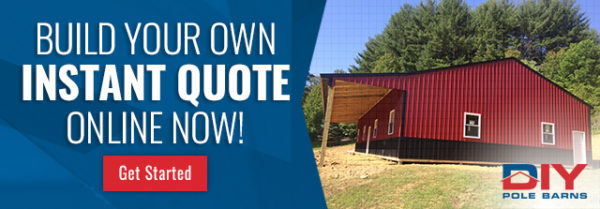When you’re planning a pole barn, a lot of decisions go into the final design. How big will you need it? How many windows and doors? What kind of pole barn garage door will you use? But there’s one important part that might be easy to overlook: your pole barn wainscoting. If you’re not familiar with the advantages of wainscoting, read on and learn more before you start planning your own unique barn!
What is Wainscot?
Traditionally, a wainscot was an area of wood paneling on the lower parts of the walls in interior rooms. It was used to help make stone buildings more comfortable to live in. The extra wood would insulate the room from the cold of the stone. Eventually, this wainscoting became used for decoration in modern buildings that no longer needed the added protection due to modern building materials.
Pole barn wainscoting is similar, with the exception that it typically uses steel. Wainscoting your pole barn involves adding a three-foot strip of steel along the outside base with a contrasting paint color, usually matching the roof. They serve both functional and aesthetic purposes, and are almost always recommended. While most pole barn wainscoting is done with steel, some owners choose to upgrade their pole barn with something more unique, such as stone.
Is There a Benefit to Pole Barn Wainscoting?
Yes! Wainscoting has remained popular for centuries for the benefits it brings. When you’re thinking of a pole barn, there are a few strong reasons to add a wainscot:
Aesthetics
When it comes to looks, wainscoting your pole barn can add a lot of appeal for a very low cost. Most pole barn owners choose to match their wainscoting to their roof paint, which helps to tie the entire building together. When compared to a flat wall color top-to-bottom, it’s easy to understand why wainscoting is a popular choice to add a stronger visual appeal to your pole barn.
As we mentioned, most wainscoting is done with steel. However, alternative materials are one way to upgrade your pole barn down the road. Things like stone, brick or vinyl siding can give you a different look and feel to your pole barn – however, they’re often not nearly as easy to replace compared to traditional steel paneling.
Protection
This is particularly important for pole barns used as garages or for agricultural equipment. Over time, it’s possible that you may end up dinging the side of your pole barn with industrial-sized equipment or just a distracted moment in your car. Or, more commonly, tools like lawnmowers or trimmers may throw rocks into your pole barn, gradually denting and wearing down the side. When you don’t have wainscot, all that damage is applied directly to the larger sheets of siding. A pole barn wainscot would absorb much of this damage, leaving the integrity of the primary structure pristine.
Which leads to one of the most popular benefits…
Easy Replacement
If you ever get to the point where typical wear-and-tear from rocks or dings has thoroughly damaged your wainscot, it’s much easier to replace. Assuming you used a standard sheet metal wainscot, you can replace it for significantly less than trying to repair and replace the primary structure. This helps keep your pole barn in good shape for longer, with less cost to you. The small investment in wainscoting when designing your original pole barn goes a long way to saving you frustration and money down the road.
Plan Your Pole Barn Today – Get an Instant Quote Online!
If you’re ready to build your pole barn, lock in a quote with DIY Pole Barns using our Instant Quote tool! Have questions? Call our knowledgeable staff at (937) 547-9100.
Connect with us on social media!




